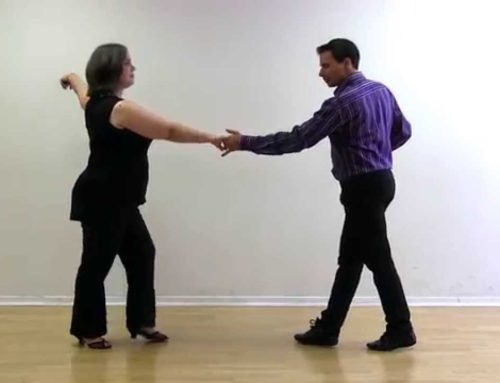Jitterbug Basic
The jitterbug basic uses the same pattern for all three rhythms of the East Coast swing. Swing dancing used single, delayed single and triple rhythms. The only difference is how many weighted steps are used for the for the side steps on counts 1,2 & 3,4. The jitterbug is also called single rhythm East Coast swing. This form of swing is a popular form that goes back to the 1930’s & 1940’s.
Swing dancing has evolved since it began in the 1920’s with the Lindy hop. The East Coast swing is often taught in dance studios. The East Coast swing has three rhythms: single, delayed single and triple rhythm. The rhythms are named by the number of weighted steps are taken for two beats, so single rhythm equals one weighted step for two beats of music. The single rhythm East Coast swing is a generic, simple form of swing dancing that some people call jitterbug. Other forms of swing dancing have used this term in the past. Here Pattie Wells does a quick review of the basic step pattern for the single rhythm East Coast swing (jitterbug). The step pattern is referred to as the jitterbug basic.
Jitterbug Basic (transcript):
Hello I’m Pattie Wells at DanceTime.com. We’re going to do the jitterbug basic today. The jitterbug, we call it the jitterbug, another term for this dance is single rhythm east coast swing. Single rhythm because we are taking a single weighted step per two beats. So, here’s the basic step starting out with the lead part.
Jitterbug Basic Lead Part:
The lead is going to move (step) to the left using a touch- right, then to the right touch-step. And a small breaking action known as a rock-step, the count is 1,2 3,4, 5,6 .
Jitterbug Basic Follow Part:
For the follow part, we start with the right foot, we move (step) to the right step-touch, then left step-touch finish with rock- step.
Jitterbug Technique:
And if you are a beginner you might want to do your rock step by just placing the ball of the foot back (not the heel) and then replace on the front foot , ball flat, so you don’t fall back to far. We use a little cushion in the knees when you step off and we do the same thing on the ball flat.
So for the jitterbug, we’re going to go side- touch, side- touch then rock- step. Now, if the song is fast we can eliminate the touch and just go step (two beats), step (two beats), rock- step, step, step, rock- step. So, the touches are just marking time, it’s a nice way to make sure your doing something on every beat of music. That’s why I prefer it (using the touches to mark the music) and have taught it that way for the last 30+ years.
Thank you for checking into DanceTime.com, my name is Pattie Wells, hopefully I’ll see you on the dance floor.
East Coast swing single rhythm (also know as Jitterbug) basic step review by Pattie Wells, who currently teaches private lessons only in San Diego. This jitterbug basic step video was filmed on location at Dance For 2 studio.













Leave A Comment
You must be logged in to post a comment.